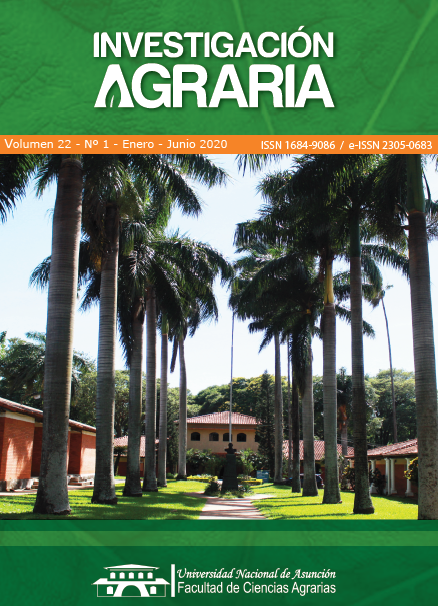Soil water balance and soybean productivity cultivated under different water deficit levels in South Brazil
DOI:
https://doi.org/10.18004/investig.agrar.2020.junio.03-12%20Abstract
The water balance of soil has been studied for several years, due to the detailed information generated and that help in understanding the availability of water in soil to the plants, in the development of agricultural crops and, consequently, in their productivity. The main objective of this work was to evaluate the dynamics of the water balance for the soybean crop [Glycine max (L.) Merrill.] submitted to different levels of water deficit and its impact on crop productivity. The experiment was conducted inside a mobile cover (Rainout shelter) in the period 2014/2015 and 2016, where four treatments with different levels of water deficit were tested: T1 (no water deficit), T2 (light water deficit), T3 moderate water deficit) and T4 (severe water deficit). The experimental design was completely randomized, with three replicates. Water balance variables such as crop evapotranspiration (ETc), irrigation, precipitation, runoff and soil water variation (ΔASW) were monitored daily. The results show an influence of the different levels of deficit irrigation and the meteorological conditions on the components of the water balance, the crop cycle, morphological characteristics and, yield components. A grains yield reduction was observed with the increase in soil water deficit, for treatments without deficit to severe deficit, from 42 to 11,5%, respectively, for year 1 and year 2, respectivelyDownloads
Metrics
References
Allen, R. G., Pereira, L. S., Raes, D. & Smith, M. (1998). Crop evapotranspiration guidelines for computing crop water requirements. Recuperado de: http://www.fao.org/tempref/SD/Reserved/Agromet/PET/FAO_Irrigation_Drainage_Paper_56.pdf
Avila, V. (2016). Balanço hídrico do solo e partição da evapotranspiração de soja, milho e feijão submetidos á irrigação deficitária no sul do Brasil. Santa Maria, Brasil.
Barbaro, I., Cruz, M., Di Mauro, A., Trevisoli, S., Arriel, N. & Osta, M. (2006). Path analysis and expected response in indirect selection for grain yield in soybean. Crop Breeding and Applied Biotechnology, 6, 151-159.
Bertagnolli, P., Strieder, M., Vernetti Junior, F. De J., Santos, F. Dos, Costa, L., Steckling, C. ... Suzuki, S. (2015). Desempenho de cultivares de soja transgênica (intacta e rr1) na macrorregião sojicola 1, avaliadas na safra 2013/14 ela rede soja sul de pesquisa. Recuperado de: https://ainfo.cnptia.embrapa.br/digital/bitstream/item/122760/1/ATA-e-Resumos-Reuniao-Soja-revisao-04-de-marco.pdf
Claus, A., Lemos, L., Heling, A., Bottcher, A. e Carré, V. (2016). Características agronômicas da soja cultivada sob três tipos de manejo. En Congresso técnico da Engenharia e da Agronomia, 29 de agosto a 1 de setembro. Foz do Iguaçu. Recuperado de: http://www.confea.org.br/sites/default/files/uploads-imce/contecc2016/agronomia/caracter%C3%ADsticas%20agron%C3%B4micas%20da.pdf
Sociedade Brasileira de Ciência do Solo, Comissão de Química e Fertilidade do Solo. (2004). Manual de adubação e calagem para os estados do Rio Grande Do Sul e Santa Catarina. Porto Alegre: Evangraf.
EMBRAPA (Empresa Brasileira De Pesquisa Agropecuária). (2015). Densidade de plantas na cultura da soja. Londrina: Embrapa Soja.
EMBRAPA (Empresa Brasileira De Pesquisa Agropecuária). (2006). Sistema Brasileiro de classificação de solos. Rio De Janeiro: Embrapa.
Fendrich, R. (2003). Chuva e produtividade da soja na fazenda gralha azul da PUCPR. Revista Academica: Ciências Agrárias e Ambientais, 1(2), 37-46.
Ferrari, E., Paz, A. e Silva, A. (2015). Déficit hídrico no metabolismo da soja em semeaduras antecipadas no Mato Grosso. Nativa, 3, 67-77.
Gava, R., Frizzone, J., Snyder, R., Almeida, B., Freitas, P. e Rezende, R. (2016). Estratégias de manejo de déficit hídrico na irrigação da cultura da soja. Brazilian Journal of Biosystems Engineering, 10(3), 305-315.
Guimarães, C., Stone, L. & Silva, A. (2016). Evapotranspiration and grain yield of upland rice as affected by water deficit. Revista Brasileira Engenharia Agrícola e Ambiental, 20 (5), 441-446.
Heldwein, A., Buriol, G. e Streck, N. (2009). O clima de Santa Maria, Rs. Ciência e Ambiente, 38, 43-58.
Hirayama, M., Wada, Y. & Nemoto, H. (2006). Estimation of drought tolerance based on leaf temperature in upland rice breeding. Breeding Science, 56, 47-54.
Kottek, M., Grieser, J., Beck, C., Rudolf, B. & Rubel, F. (2006). World map of the koppen-geiger climate classification updated. Meteorologische Zeitschrift, 15(3), 259-263.
Lima, S., Frizzone, J., Mateos, L. e Fernandez, M. (2012). Estimativa da produtividade de água em uma área irrigada no sul da Espanha. Revista Brasileira de Agricultura Irrigada, 6(1), 51-60.
Molden, D., Binb, D., Loevec, R., Barkera, R. & Tuong, T. (2007). Agricultural water productivity and savings: policy lessons from two diverse sites in China. Water Policy, 9, 29-44.
Payero, J., Melvin, S. & Irmak, S. (2005). Response of soybean to the deficit irrigation in the semi-arid environment of west-central Nebraska. American Society of Agricultural Engineers, 48, 2189-2203.
Perini, L., Fonseca Junior, N., Destro, D. e Prete, C. (2012). Componentes da produção em cultivares de soja com crescimento determinado e indeterminado. Ciências Agrárias, 33(1), 2531-2544.
Simeão, M. (2015). Crescimento e produtividade de grãos de soja sob déficit hídrico no solo. Bom Jesus, Brasil.
Specht, J., Chase, K., Macrander, M., Graef, G., Chung, J., Markwell, J., … Lark, K. (2001). Soybean response to water: a qtl analysis of drought tolerance. Crop Science, 41(2), 493-509.
Thomas, A., Costa, J. (2010). Desenvolvimento da planta de soja e o potencial de rendimento de grãos. In: Thomas, A., Costa, J. (Ed.). Soja: Manejo Para Alta Produtividade De Grãos. Porto Alegre: Evangraf , 13-33.
Published
How to Cite
Issue
Section
License
Copyright (c) 2020 Investigación Agraria

This work is licensed under a Creative Commons Attribution 4.0 International License.
All content in this journal is under Creative Commons Attribution License.









 All content in this journal is under
All content in this journal is under 